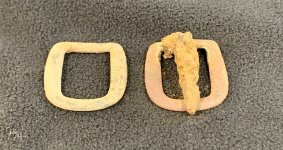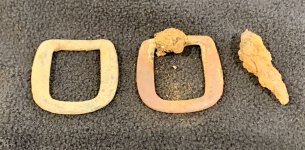brianc053
Hero Member
- Jan 27, 2015
- 987
- 3,443
- 🏆 Honorable Mentions:
- 3
- Detector(s) used
- Minelab Equinox 800
XP Deus 2
- Primary Interest:
- Metal Detecting
Hi everyone. I haven't found much recently; I've had a bit of a dry spell.
But today I found matching buckles at a house in the historic downtown of my town, and one of them appears to have the prong intact.
First - isn't it weird that I found two matching buckles about 30 feet apart and at different depths? What are the chances, I wonder?
Second, how do I clean the buckle with the prong so that I don't destroy the prong? From looking at it I think that's a "concretion" around the prong; you can see a little piece of almost-pink quartz stuck to the concretion in one of the pictures. I don't want to damage the prong, if it's possible to save it.
Should I soak it in something? Hydrogen peroxide? Vinegar? Just soap and water?
Lastly, is there any way to estimate a date on rather plain buckles like these? I'm guessing they could be from almost any time (much like horseshoes), but if anyone has ideas on estimated age I'd appreciate your thoughts.
Thanks everyone!
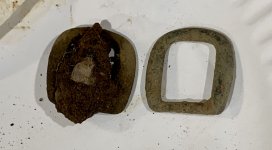
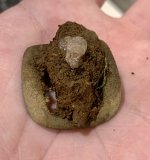
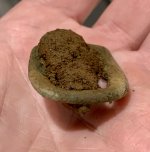
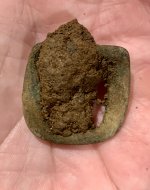
But today I found matching buckles at a house in the historic downtown of my town, and one of them appears to have the prong intact.
First - isn't it weird that I found two matching buckles about 30 feet apart and at different depths? What are the chances, I wonder?
Second, how do I clean the buckle with the prong so that I don't destroy the prong? From looking at it I think that's a "concretion" around the prong; you can see a little piece of almost-pink quartz stuck to the concretion in one of the pictures. I don't want to damage the prong, if it's possible to save it.
Should I soak it in something? Hydrogen peroxide? Vinegar? Just soap and water?
Lastly, is there any way to estimate a date on rather plain buckles like these? I'm guessing they could be from almost any time (much like horseshoes), but if anyone has ideas on estimated age I'd appreciate your thoughts.
Thanks everyone!




Amazon Forum Fav 👍
Upvote
3




